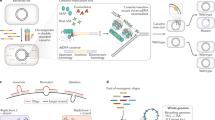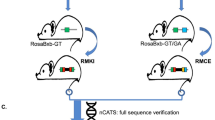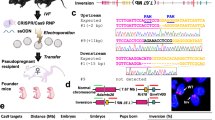Abstract
We report here a high-throughput method for the modification of bacterial artificial chromosomes (BACs) that uses a novel two-plasmid approach. In this protocol, a vector modified in our laboratory to hold an R6Kγ origin of replication and a marker recombination cassette is inserted into a BAC in a single recombination step. Temporal control of recombination is achieved through the use of a second plasmid, pSV1.RecA, which possesses a recombinase gene and a temperature-sensitive origin of replication. This highly efficient protocol has allowed us to successfully modify more than 2,000 BACs, from which over 1,000 BAC transgenic mice have been generated. A complete cycle from BAC choice to embryo implantation takes about 5 weeks. Marker genes introduced into the mice include EGFP and EGFP-L10a. All vectors used in this project can be obtained from us by request, and the EGFP reporter mice are available through the Mutant Mouse Regional Resource Center (NINDS/GENSAT collection). CNS anatomical expression maps of the mice are available to the public at http://www.gensat.org/.
This is a preview of subscription content, access via your institution
Access options
Subscribe to this journal
Receive 12 print issues and online access
$259.00 per year
only $21.58 per issue
Buy this article
- Purchase on Springer Link
- Instant access to full article PDF
Prices may be subject to local taxes which are calculated during checkout






Similar content being viewed by others
References
Monaco, A.P. & Larin, Z. YACs, BACs, PACs and MACs: artificial chromosomes as research tools. Trends Biotechnol. 12, 280–286 (1994).
Giraldo, P. & Montoliu, L. Size matters: use of YACs, BACs and PACs in transgenic animals. Transgenic. Res. 10, 83–103 (2001).
Shizuya, H. et al. Cloning and stable maintenance of 300-kilobase-pair fragments of human DNA in Escherichia coli using an F-factor-based vector. Proc. Natl. Acad. Sci. USA 89, 8794–8797 (1992).
Ioannou, P.A. et al. A new bacteriophage P1-derived vector for the propagation of large human DNA fragments. Nat. Genet. 6, 84–89 (1994).
Marra, M.A. et al. High throughput fingerprint analysis of large-insert clones. Genome Res. 7, 1072–1084 (1997).
Kelley, J.M. et al. High throughput direct end sequencing of BAC clones. Nucleic Acids Res. 27, 1539–1546 (1999).
Osoegawa, K. & de Jong, P.J. BAC library construction. Methods Mol. Biol. 255, 1–46 (2004).
Mozo, T. et al. A complete BAC-based physical map of the Arabidopsis thaliana genome. Nat. Genet. 22, 271–275 (1999).
Hoskins, R.A. et al. A BAC-based physical map of the major autosomes of Drosophila melanogaster. Science 287, 2271–2274 (2000). Erratum in Science 288, 1751 (2000).
Osoegawa, K. et al. Bacterial artificial chromosome libraries for mouse sequencing and functional analysis. Genome Res. 10, 116–128 (2000).
McPherson, J.D. et al. A physical map of the human genome. Nature 409, 934–941 (2001).
Shizuya, H. & Kouros-Mehr, H. The development and applications of the bacterial artificial chromosome cloning system. Keio J. Med. 50, 26–30 (2001).
Yang, X.W., Model, P. & Heintz, N. Homologous recombination based modification in Escherichia coli and germline transmission in transgenic mice of a bacterial artificial chromosome. Nat. Biotechnol. 15, 859–865 (1997).
Heintz, N. BAC to the future: the use of bac transgenic mice for neuroscience research. Nat. Rev. Neurosci. 2, 861–870 (2001).
Lalioti, M. & Heath, J.A. A new method for generating point mutations in bacterial artificial chromosomes by homologous recombination in Escherichia coli. Nucleic Acids Res. 29, E14 (2001).
Gong, S., Yang, X.W., Li, C. & Heintz, N. Highly efficient modification of bacterial artificial chromosomes (BACs) using novel shuttle vectors containing the R6Kgamma origin of replication. Genome Res. 12, 1992–1998 (2002).
Ohtsuka, M., Kimura, M., Tanaka, M. & Inoko, H. Recombinant DNA technologies for construction of precisely designed transgene constructs. Curr. Pharm. Biotechnol. 10, 244–251 2009.
Zhang, Y., Buchholz, F., Muyrers, J.P. & Stewart, A.F. A new logic for DNA engineering using recombination in Escherichia coli. Nat. Genet. 20, 123–128 (1998).
Murphy, K.C. Use of bacteriophage lambda recombination functions to promote gene replacement in Escherichia coli. J. Bacteriol. 180, 2063–2071 (1998).
Sharan, S.K., Thomason, L.C., Kuznetsov, S.G. & Court, D.L. Recombineering: a homologous recombination-based method of genetic engineering. Nat. Protoc. 4, 206–223 (2009).
Lee, E.C. et al. A highly efficient Escherichia coli–based chromosome engineering system adapted for recombinogenic targeting and subcloning of BAC DNA. Genomics 73, 56–65 (2001).
Metcalf, W.W. et al. Conditionally replicative and conjugative plasmids carrying lacZ alpha cloning, mutagenesis, and allele replacement in bacteria. Plasmid 35, 1–13 (1996).
Gay, P., Le Coq, D., Steinmetz, M., Berkelman, T. & Kado, C.I. Positive selection procedure for the entrapment of insertion sequence elements in gram-negative bacteria. J. Bacteriol. 164, 918–921 (1985).
Gong, S. et al. A gene expression atlas of the central nervous system based on bacterial artificial chromosomes. Nature 425, 917–925 (2003).
Wiedenmann, J., Oswald, F. & Nienhaus, G.U. Fluorescent proteins for live cell imaging: opportunities, limitations, and challenges. IUBMB Life 61, 1029–1042 (2009).
Heiman, M. et al. A translational profiling approach for the molecular characterization of CNS cell types. Cell 135, 738–748 (2008).
Doyle, J.P. et al. Application of a translational profiling approach for the comparative analysis of CNS cell types. Cell 135, 749–762 (2008).
Chrast, R., Scott, H.S. & Antonarakis, S.E. Linearization and purification of BAC DNA for the development of transgenic mice. Transgenic Res. 8, 147–150 (1999).
Gong, S. & Yang, W.X. Modification of bacterial artificial chromosomes (BACs) and preparation of intact BAC DNA for generation of transgenic mice. Curr. Protoc. Neurosci. Chapter 5: Unit 5.21 (2005).
Conner, D.A. Transgenic mouse production by zygote injection. Curr. Protoc. Mol. Biol. Chapter 23: Unit 23.9 (2004).
Geschwind, D. GENSAT: a genomic resource for neuroscience research. Lancet Neurol. 3, 82 (2004).
Hatten, M.E. & Heintz, N. Large-scale genomic approaches to brain development and circuitry. Annu. Rev. Neurosci. 28, 89–108 (2005).
Abe, K., Hazama, M., Katoh, H., Yamamura, K. & Suzuki, M. Establishment of an efficient BAC transgenesis protocol and its application to functional characterization of the mouse Brachyury locus. Exp. Anim. 53, 311–320 (2004).
Acknowledgements
We acknowledge C. Wang and S. Mehta for their valuable contribution to the development of the protocol described in this report and we thank S. Mehta and M. Almahariq for critical reading of the paper. We thank Z.D. Barrera for assistance with Figure 2 and J. Walsh for her untiring help with plasmid distribution to the scientific community. This work was supported by an NIH/NINDS contract N01 NS-7-2370, the Simons Foundation; N.H. is a Howard Hughes Medical Institute investigator.
Author information
Authors and Affiliations
Contributions
N.H. conceptualized and directed the project. N.H. and S.G. developed the high-throughput method of BAC modification that uses a single recombination step. S.G. designed and conducted experiments. S.G. analyzed data; L.K. improved quality, condensed and summarized the protocol and wrote the paper; L.K. performed confocal microscopy.
Corresponding authors
Ethics declarations
Competing interests
The authors declare no competing financial interests.
Rights and permissions
About this article
Cite this article
Gong, S., Kus, L. & Heintz, N. Rapid bacterial artificial chromosome modification for large-scale mouse transgenesis. Nat Protoc 5, 1678–1696 (2010). https://doi.org/10.1038/nprot.2010.131
Published:
Issue Date:
DOI: https://doi.org/10.1038/nprot.2010.131
This article is cited by
-
Deviant reporter expression and P2X4 passenger gene overexpression in the soluble EGFP BAC transgenic P2X7 reporter mouse model
Scientific Reports (2020)
-
Dissection and function of autoimmunity-associated TNFAIP3 (A20) gene enhancers in humanized mouse models
Nature Communications (2018)
-
Dll4 and Notch signalling couples sprouting angiogenesis and artery formation
Nature Cell Biology (2017)
-
The RNA-binding protein Celf6 is highly expressed in diencephalic nuclei and neuromodulatory cell populations of the mouse brain
Brain Structure and Function (2016)
-
Evolution of the new vertebrate head by co-option of an ancient chordate skeletal tissue
Nature (2015)
Comments
By submitting a comment you agree to abide by our Terms and Community Guidelines. If you find something abusive or that does not comply with our terms or guidelines please flag it as inappropriate.



